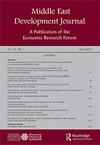Population dynamics and CO2 emissions in the Arab region: an extended STIRPAT II model
IF 0.9
Q4 DEVELOPMENT STUDIES
引用次数: 16
Abstract
ABSTRACT Many Arab countries have been developing in a fast pace over the last two decades. This is now seen as putting considerable pressure on the natural environment through population growth, ecosystem stress and resource extraction. The potential for climate change arising from increasing carbon dioxide emissions threatens the likelihood of a more sustainable development model being achieved in many of these countries. The paper deals with Arab countries’ population-environment nexus with respect to climate change interactions. The paper adopts the STIRPAT II model, which measures the effect of population, wealth, technology and, institution quality on the environment. Carbon dioxide (CO2) emissions is adopted to measure the environmental impact. Both the static panel models and the dynamic heterogeneous panel models were employed to test the concept of ecological elasticity in the Arab world. The results show that the most efficient way for the Arab countries to minimize carbon emissions is to reduce population, affluence, energy intensity and enhance the institution quality. However, the Arab countries are currently on a trajectory of growing population and affluence.阿拉伯区域的人口动态和二氧化碳排放:扩展的STIRPAT II模型
在过去的二十年里,许多阿拉伯国家一直在快速发展。人们现在认为,人口增长、生态系统压力和资源开采给自然环境带来了相当大的压力。二氧化碳排放增加可能引起气候变化,这威胁到许多这些国家实现更可持续发展模式的可能性。本文讨论了阿拉伯国家在气候变化相互作用方面的人口-环境关系。本文采用STIRPAT II模型来衡量人口、财富、技术和制度质量对环境的影响。采用二氧化碳(CO2)排放量来衡量环境影响。采用静态面板模型和动态异质性面板模型对阿拉伯世界的生态弹性概念进行检验。研究结果表明,减少人口、富裕程度、能源强度和提高制度质量是阿拉伯国家实现碳排放最小化的最有效途径。然而,阿拉伯国家目前正处于人口和财富不断增长的轨道上。
本文章由计算机程序翻译,如有差异,请以英文原文为准。
求助全文
约1分钟内获得全文
求助全文

 求助内容:
求助内容: 应助结果提醒方式:
应助结果提醒方式:


